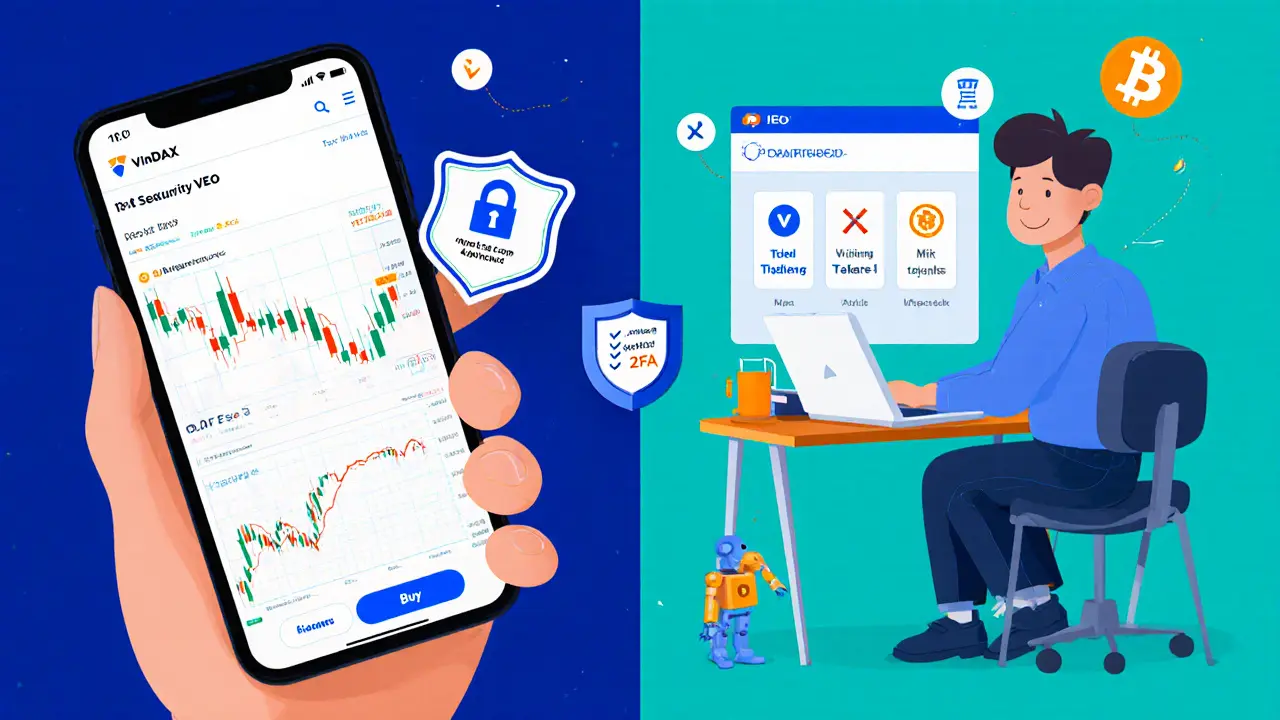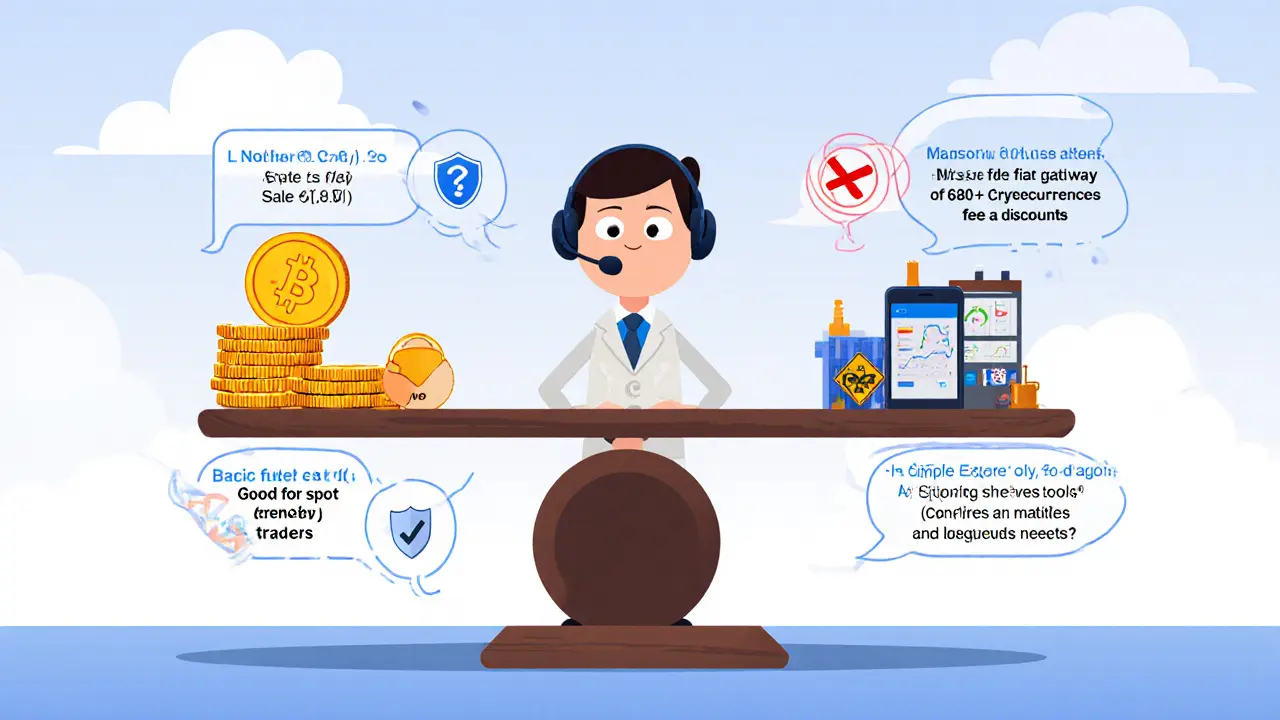VinDAX Fee Calculator
Calculate Your VinDAX Trading Fees
Enter your monthly trading volume and check if you qualify for VD token discounts.
Estimated Monthly Trading Fees
Fee Comparison Chart
| Exchange | Maker Fee | Taker Fee | Fee Discount with Native Token |
|---|---|---|---|
| VinDAX | 0.10% | 0.10% | 0.05%-0.08% (VD holders) |
| Binance | 0.10% | 0.10% | 0.075%-0.02% (BNB holders) |
| Coinbase | 0.00% | 0.50% | None |
If you’ve been hunting for a low‑fee spot‑trading platform that doesn’t overwhelm you with futures contracts, you’ve probably run into VinDAX a Vietnamese‑based crypto exchange launched in March2019, serving over 1.5million users worldwide. In this VinDax review we’ll break down what the exchange actually offers, how its fee structure stacks up against the competition, and where its security and feature set fall short. By the end you’ll know whether VinDAX is a good fit for a beginner with a few coins to swing, a cost‑conscious day trader, or someone who needs the heavy‑weight tools you find on Binance or Coinbase.
What you get when you sign up
The onboarding flow is straightforward: create an account, verify your email, and then complete the four‑tier KYC process (see the KYC verification description below). Because VinDAX only accepts crypto deposits, you’ll need to buy Bitcoin, Ethereum or any supported coin on another platform before you can start trading here. The minimum trade size is $30, but there’s no minimum deposit, which is nice for those who want to dip a toe in with a small stash.
Markets and token lineup
VinDAX lists more than 680 cryptocurrencies across four market types: the native VD token market, USDT‑based pairs, ETH‑based pairs, and BTC‑based pairs. The VD token isn’t just a logo; holding it trims your trading fees by 0.02-0.03percentage points, making it a practical discount tool for frequent traders.
Fee structure in plain English
Fees are where VinDAX tries to stand out. The exchange uses a flat 0.10% fee for both makers and takers on most markets. If you trade in the VD market while holding VD tokens, you pay between 0.05% and 0.08%. Compare that to the global averages of 0.221% (takers) and 0.177% (makers), and the savings become clear.
| Exchange | Maker fee | Taker fee | Fee discount with native token |
|---|---|---|---|
| VinDAX | 0.10% | 0.10% | 0.05%-0.08% (VD holders) |
| Binance | 0.10% | 0.10% | 0.075%-0.02% (BNB holders) |
| Coinbase | 0.00% | 0.50% | None |
Withdrawal fees are also competitive-Bitcoin withdrawals cost 0.0005BTC, roughly 40% lower than the industry average of 0.000812BTC.
Key features you’ll actually use
- Spot trading with deep liquidity on high‑volume pairs.
- Integrated IEO launchpad that lets you join token presales using various base assets.
- Basic trading bot support and signal integration for automated strategies.
- Mobile apps for iOS and Android that mirror the desktop terminal.
- 24/7 live chat and active Telegram communities (see Telegram channels) for peer‑to‑peer help.
What VinDAX lacks
For traders used to the full suite of products on top exchanges, the gaps are obvious:
- No futures, options, or margin trading.
- No copy‑trading or social‑trading marketplace.
- Limited staking, lending, or DeFi integration.
- Security measures stop at two‑factor authentication (2FA), anti‑phishing codes, and optional whitelist addresses (see 2FA); there’s no hardware‑wallet integration or cold‑storage guarantees advertised.
These omissions keep the platform in the mid‑tier category, appealing mainly to cost‑conscious spot traders rather than institutional players.

Security snapshot
VinDAX offers the basics: email verification, 2FA, withdrawal whitelist, and IP‑address monitoring. However, independent security audits are not publicly posted, and the exchange does not provide insurance funds for potential breaches. Compared with industry leaders like Binance (which runs regular third‑party audits) and Coinbase (which holds a $250million insurance fund), VinDAX’s security posture feels modest.
API and institutional tools
Developers and algo‑traders can tap into a RESTful API that supports market data, order placement, and account management. The documentation is decent but lacks extensive example code for advanced order types. Institutional users can request OTC desk access, but the process is manual and not advertised on the main site.
How to get started in 5 steps
- Sign up on the VinDAX website and verify your email.
- Complete the four‑level KYC (upload ID, selfie, proof of address, and optional source‑of‑funds).
- Deposit a supported cryptocurrency (BTC, ETH, USDT, etc.) to your VinDAX wallet.
- Enable 2FA and, if desired, add a withdrawal whitelist for extra safety.
- Navigate to the Spot Trading tab, pick a market (e.g., BTC/USDT), and place your first trade.
Because there’s no fiat on‑ramp, you’ll need to purchase crypto elsewhere (e.g., on Binance) before completing step3.
Pros and cons at a glance
| Pros | Cons |
|---|---|
| Low flat fees (0.10% taker/maker) | No fiat deposit/withdrawal support |
| Large crypto selection (680+ coins) | Missing futures, margin, copy‑trading |
| VD token fee discounts | Basic security - no public audits |
| Mobile apps mirror desktop features | Limited institutional tools and OTC visibility |
Is VinDAX right for you?
Use the following decision guide:
- If you trade only spot pairs and want the cheapest fees, VinDAX is a solid pick.
- If you need futures, options, or a built‑in fiat gateway, look at Binance, Bybit, or Coinbase.
- If you are a security‑focused trader, prioritize platforms with published audit reports and insurance funds.
- If you already hold VD tokens, the extra discount nudges the cost advantage further.
Future outlook
Recent public statements from VinDAX are limited, but the exchange appears to be focusing on incremental improvements-adding more IEO projects, polishing the mobile UI, and modestly expanding OTC access. Without a clear roadmap toward derivatives or enhanced security certifications, its market share will likely stay in the niche of low‑fee spot traders.

Frequently Asked Questions
Can I deposit fiat on VinDAX?
No. VinDAX only accepts cryptocurrency deposits. To trade you’ll need to acquire crypto on another exchange first.
What is the fee discount for holding VD tokens?
VD token holders enjoy a 0.05%-0.08% trading fee on the VD market, compared with the standard 0.10% flat fee.
Is VinDAX safe for large deposits?
VinDAX provides basic security (2FA, anti‑phishing, whitelist), but it lacks public audit reports and insurance funds. Large investors may prefer exchanges with stronger security guarantees.
Does VinDAX offer a mobile app?
Yes. The iOS and Android apps provide full spot‑trading functionality, including order types, market data, and account management.
How does the IEO launchpad work?
VinDAX’s launchpad lets users allocate funds (BTC, USDT, VD, etc.) to token presale projects. Participants receive allocation based on the amount contributed during the IEO window.


Thank you for the thorough overview; the clarity regarding fee structures and security measures is much appreciated. It is encouraging to see the inclusion of both spot‑trading features and the IEO launchpad, which may benefit newcomers seeking a straightforward platform.
Honestly, the crypto world should be ashamed, utterly careless, and frankly, morally bankrupt, when exchanges like VinDAX skimp on audit transparency, yet still dare to lure users with "low fees"! It reads like a siren song for the unwary, a thin veil over reckless profiteering, and I cannot stress enough how deeply disturbing this is.
Hey folks, great post! I think the low‑fee spot‑trading focus is perfect for traders who just want to dip their toes in without worrying about complex instruments. If you’re new, start small, get comfortable with the UI, and maybe hold a few VD tokens for that extra discount – it’s a sweet little boost.
From a technical standpoint, VinDAX’s RESTful API, while functional, lacks comprehensive example snippets for advanced order types like ice‑berg or conditional orders, which could be a hurdle for algo‑traders. Moreover, the absence of a native WebSocket feed for real‑time depth data forces developers to rely on third‑party aggregators, potentially introducing latency. The OTC desk workflow is also notably manual – you must submit a KYC‑verified request and wait for a compliance response, which isn’t ideal for institutional liquidity needs.
Listen up, everyone-VinDAX’s fee model is a genuine boon for high‑volume traders, especially when you lock in the VD token discount; the savings compound quickly, and that’s a massive advantage over platforms that charge hidden premiums. Additionally, the mobile app mirrors the desktop experience flawlessly, so you can pivot between devices without missing a beat, which, frankly, is essential in today’s fast‑paced markets.
When dissecting VinDAX’s fee architecture, one must first acknowledge the seemingly modest 0.10% flat rate across both maker and taker orders, which on its face appears competitive. However, this nominal figure belies a deeper consideration: the effective cost to a trader is contingent upon the proportion of VD token holdings, sliding the fee down to a range of 0.05%–0.08%, a reduction that may seem marginal yet can accrue significantly over time, particularly for high‑frequency strategies.
Beyond the headline percentages, the exchange’s withdrawal fees deserve scrutiny. A Bitcoin withdrawal cost of 0.0005 BTC translates to roughly $10‑$12 depending on market price, positioning VinDAX well below the industry average of 0.000812 BTC. This reduction can be a decisive factor for users who frequently rebalance their portfolios or liquidate positions.
Security, however, remains a more contentious domain. VinDAX employs standard two‑factor authentication, anti‑phishing codes, and optional whitelist addresses, but it conspicuously lacks publicly audited security reports. In an environment where custodial risk is paramount, the absence of third‑party audit documentation may erode user confidence, especially for institutional participants seeking verifiable safeguards.
From a product feature perspective, VinDAX’s spot‑trading suite is robust, offering over 680 cryptocurrency pairs across BTC, ETH, USDT, and the native VD token markets. The inclusion of an IEO launchpad and rudimentary bot integration adds a layer of utility for users interested in emerging projects. Nonetheless, the platform’s inability to support derivatives, margin, or copy‑trading limits its appeal to more sophisticated traders who demand a comprehensive suite of instruments.
On the API front, while the exchange provides a functional RESTful endpoint for market data and order execution, the documentation lacks depth, particularly regarding advanced order types and error handling. This shortfall can impede algorithmic developers who require granular control and comprehensive fallback mechanisms.
In conclusion, VinDAX positions itself as an attractive venue for cost‑conscious spot traders, offering a competitive fee schedule, reasonable withdrawal costs, and a broad asset selection. Yet, its modest security posture, absence of advanced trading products, and limited transparency around audits represent notable drawbacks. Prospective users must weigh these trade‑offs against their specific trading goals and risk tolerance.
That analysis is overly flattering; the platform’s “low fees” are just a marketing ploy, and the security gaps are a glaring red flag for anyone with serious capital.
Oh, sure, because VinDAX’s “transparent” fee tables are the pinnacle of innovation-next you’ll tell us the moon is made of cheese.
Let’s focus on the positives, folks-those fee discounts can genuinely help small traders grow their portfolios without feeling the pinch.
Fees look overpriced.